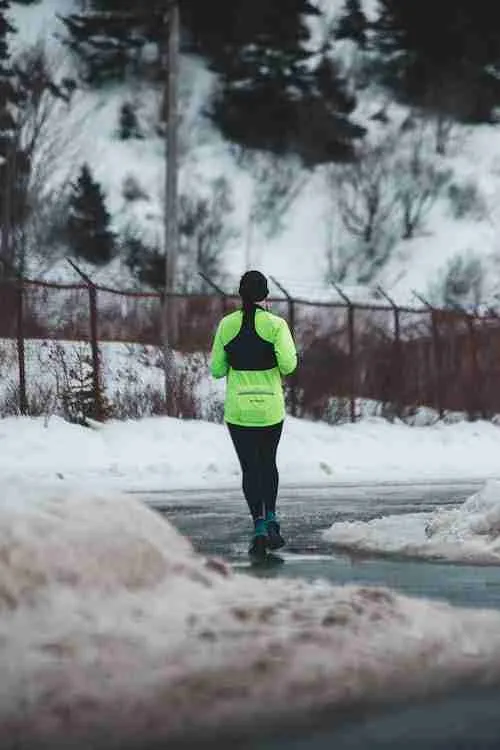
Running in the cold | Benefits and Gear

14 min read
As the temperature drops and winter sets in, many runners may find themselves hesitant to hit the pavement. However, running in the cold can actually have many benefits and with the right gear and preparation, it can be an enjoyable and invigorating experience.
In this article, we will explore the benefits of running in the cold, the best way to get started, the gear you need, the right way to dress, how to warm up, and the importance of cooling down and stretching.
The Benefits of Running in the Cold
Running in the cold can provide a number of benefits for both your physical and mental health. The cold air can help to increase your lung capacity and improve your overall cardiovascular fitness. Additionally, running in the cold can boost your metabolism, leading to increased calorie burn and potential weight loss.

Running in the cold weather has a number of benefits. First, it can help to improve your cardiovascular health. Running in the cold can also help to burn more calories, as your body works harder to keep warm.
-
Improved Endurance and Performance
- Enhanced Oxygen Utilization: In cooler temperatures, your body can more efficiently utilize oxygen, which can improve endurance and overall performance.
- Reduced Overheating: Running in the cold minimizes the risk of overheating, allowing you to maintain a steady pace without feeling as fatigued as quickly.
-
Increased Calorie Burn
- Thermogenesis: Cold weather forces your body to work harder to maintain its core temperature, burning additional calories during your run.
- Fat Utilization: Your body tends to use more fat as a fuel source in colder conditions.
-
Boosted Mental Resilience
- Mental Toughness: Running in challenging conditions builds mental toughness, strengthening your resolve.
- Mood Enhancement: Cold weather running can boost your mood and reduce symptoms of seasonal affective disorder (SAD).
| Benefit | Details |
|---|---|
| Improved Endurance and Performance | - Enhanced Oxygen Utilization: Cooler temperatures allow your body to use oxygen more efficiently, boosting endurance and performance. - Reduced Overheating: Running in the cold reduces the risk of overheating, helping you maintain a steady pace with less fatigue. |
| Increased Calorie Burn | - Thermogenesis: Your body burns more calories in cold weather as it works harder to stay warm. - Fat Utilization: Cold conditions encourage your body to use more fat as a fuel source. |
| Boosted Mental Resilience | - Mental Toughness: Running in challenging cold conditions builds mental toughness. - Mood Enhancement: Cold weather runs can improve your mood and help alleviate seasonal affective disorder (SAD). |
| Strengthened Immune System | - Cold Exposure: Regular exposure to cold weather can enhance your immune system’s adaptability. - Reduced Inflammation: Cold temperatures naturally reduce inflammation by lowering the body’s inflammatory response. |
| Increased Mental Focus | - Sharper Mind: Running in the cold sharpens mental focus and keeps you alert. - Better Sleep: Physical exertion in cold weather can lead to better sleep quality. |
| Less Crowded Running Paths | - More Space: Cold weather means fewer people out running, giving you more space. - Peaceful Environment: The cold creates a serene and quiet atmosphere, perfect for a meditative run. |
| Enhanced Recovery Post-Run | - Quicker Recovery: Cold temperatures act like a natural ice bath, reducing muscle soreness and speeding up recovery. - Reduced Swelling: Running in the cold helps to minimize swelling and muscle inflammation. |
| Builds Consistency | - Habit Formation: Running in cold weather helps you maintain a consistent exercise routine year-round. |
The Best Way to Get Started
There’s no one answer for this question, since everyone has different writing styles and methods that work best for them. However, some general advice on how to get started writing an essay would be to first brainstorm a topic, make an outline of the main points you want to cover, and then start writing a draft. After you have a rough draft, you can then revise and edit it to make it better. Additionally, it can be helpful to get someone else to read your essay to give you feedback on what could be improved.

If you are new to running in the cold, it is important to start slowly and gradually build up your tolerance to the lower temperatures. Begin by running for shorter distances at a slower pace and gradually increase both the distance and intensity of your runs as your body adjusts to the cold.
-
Prepare Mentally
- Set Realistic Goals: Start with achievable goals to build confidence and gradually increase your running distance and intensity.
- Embrace the Challenge: Acknowledge that running in the cold is different but can be rewarding. Focus on the benefits, like improved mental toughness and better endurance.
-
Dress Appropriately
- Layer Up: Use moisture-wicking base layers to keep sweat off your skin, a mid-layer for insulation, and an outer layer that’s wind and water-resistant.
- Protect Extremities: Wear gloves, a hat, and thermal socks to protect your hands, head, and feet from the cold.
- Avoid Overdressing: Dress as if it’s 10-20 degrees warmer than the actual temperature. You should feel slightly chilly when you start.
-
Warm-Up Thoroughly
- Dynamic Warm-Up: Engage in a dynamic warm-up indoors to increase your body temperature and get your muscles ready. Try exercises like leg swings, high knees, and lunges.
- Start Slow: Begin your run at a slower pace to give your body time to adjust to the cold before picking up speed.
-
Focus on Breathing
- Breathe Through Your Nose: Breathing through your nose can help warm the air before it reaches your lungs, making it more comfortable in cold weather.
- Use a Scarf or Buff: If the air is very cold, wear a scarf or buff over your mouth to warm the air as you breathe.
-
Choose the Right Route
- Avoid Windy Areas: Opt for routes that are shielded from the wind, like wooded trails or streets with buildings that block the wind.
- Stay Safe: Run on well-lit, familiar paths to reduce the risk of slipping or tripping, especially if there’s snow or ice.
-
Stay Visible
- Wear Reflective Gear: With shorter daylight hours, ensure you’re visible to others by wearing reflective clothing or accessories.
- Use a Headlamp: A headlamp or other light source can help you see and be seen, especially in low-light conditions.
-
Hydrate and Fuel Properly
- Pre-Hydrate: Drink water before your run since cold weather can make you feel less thirsty, even though you’re still losing fluids.
- Carry Water: Consider carrying a small water bottle if you’re running longer distances, as dehydration can occur even in the cold.
-
Cool Down and Change Quickly
- Cool Down Gradually: Slow down your pace towards the end of your run and perform some light stretches to cool down.
- Change Out of Wet Clothes: Once you’re done, change out of your sweaty clothes immediately to avoid getting chilled, which can increase the risk of hypothermia.
-
Listen to Your Body
- Monitor for Signs of Cold Stress: Pay attention to how your body feels. If you start to shiver uncontrollably, feel extremely fatigued, or lose coordination, get indoors quickly.
- Start Slow, Progress Gradually: If you’re new to running in the cold, start with shorter, slower runs and gradually increase the duration and intensity as your body adapts.
It is also important to listen to your body and pay attention to any signs of discomfort or overexertion. Be sure to stay hydrated, wear appropriate clothing, and take breaks as needed.
The Gear You Need
When running in the cold, it is essential to wear the right gear to ensure that you stay warm and comfortable throughout your run. Invest in a good pair of thermal leggings, a moisture-wicking base layer, a windproof jacket, and a hat and gloves to protect your extremities.
The Gear You Need for Running in the Cold
-
Base Layer
- Moisture-Wicking Fabric: Choose a base layer made from moisture-wicking materials like merino wool or synthetic fabrics (e.g., polyester). This layer keeps sweat off your skin, preventing you from getting cold.
- Fit: The base layer should be snug but not too tight, allowing for full range of motion while trapping warmth close to your body.
-
Mid Layer
- Insulating Layer: This layer should provide insulation by trapping body heat. Options include fleece or lightweight down jackets.
- Breathability: Choose a mid-layer that offers warmth but still allows moisture to escape to avoid feeling clammy.
-
Outer Layer
- Windproof and Water-Resistant Jacket: An outer shell that protects against wind and light rain or snow is essential. Look for jackets made from materials like Gore-Tex or other breathable, water-resistant fabrics.
- Ventilation: Opt for jackets with zippers or vents to regulate your body temperature if you start to overheat.
-
Legwear
- Thermal Tights: Wear thermal or fleece-lined running tights to keep your legs warm without restricting movement.
- Layering Option: On extremely cold days, consider wearing a pair of wind-resistant pants over your tights.
-
Footwear
- Running Shoes: Choose shoes with good traction, especially if you’re running on snowy or icy surfaces. Trail running shoes can be a good option.
- Waterproofing: Consider shoes with waterproof uppers, or use waterproof socks to keep your feet dry.
- Warm Socks: Wear thermal socks or merino wool socks to keep your feet warm while wicking moisture away.
-
Headgear
- Thermal Hat or Beanie: Keep your head warm with a thermal hat or beanie made from moisture-wicking fabric.
- Headband or Ear Warmers: If you prefer not to wear a full hat, a headband or ear warmers can protect your ears from the cold.
-
Gloves
- Thermal Gloves: Wear gloves designed for cold weather running. Look for ones that are insulated yet breathable.
- Touchscreen Compatibility: Gloves with touchscreen compatibility allow you to use your phone or fitness watch without removing them.
-
Neck Gaiter or Buff
- Neck Protection: A neck gaiter or buff made from thermal material can keep your neck warm and can be pulled up over your mouth and nose to warm the air you breathe.
-
Reflective Gear
- Reflective Vest or Jacket: With shorter daylight hours, wearing a reflective vest or jacket ensures you are visible to others, especially in low-light conditions.
- Reflective Accessories: Consider adding reflective tape to your gear or using accessories like reflective arm bands.
-
Lighting
- Headlamp or Handheld Light: A headlamp or small handheld light helps you see and be seen when running in the dark.
- Clip-On Lights: Attach clip-on lights to your clothing or shoes for extra visibility.
-
Hydration Pack or Belt
- Insulated Hydration System: If you’re running long distances, an insulated hydration pack or belt keeps your water from freezing and ensures you stay hydrated.
- Small Water Bottle: For shorter runs, carry a small, handheld water bottle with an insulated sleeve.
-
Optional Extras
- Running Gaiters: If you’re running in snow, gaiters can prevent snow from getting into your shoes.
- Yaktrax or Microspikes: For icy conditions, consider adding traction devices like Yaktrax or microspikes to your running shoes for better grip.
Final Considerations:
- Test Your Gear: Test your gear in different conditions to find what works best for you.
- Layer Wisely: Adjust your layers based on the weather, and remember you can always remove a layer if you get too warm.
- Invest in Quality: High-quality gear can make a significant difference in comfort and safety when running in the cold.
Be sure to wear reflective gear and bright colors to stay visible to vehicles and other runners, especially in low light conditions. Consider investing in a pair of trail running shoes with extra traction to prevent slipping on icy or snowy surfaces.
The Right Way to Dress: Layers of Clothing
When dressing for cold weather running, it is important to layer your clothing to trap heat and keep your body temperature regulated. Start with a moisture-wicking base layer to draw sweat away from your skin, followed by an insulating layer to keep you warm, and finish with a windproof and waterproof outer layer to protect you from the elements.
Avoid wearing cotton as it can trap moisture next to your skin and lead to chafing and discomfort. Instead, opt for synthetic materials or merino wool that will keep you warm and dry throughout your run.
Planning Your Run in Very Cold Weather: What to Do Before, During, and After
Running in very cold weather requires extra precautions and planning. Before your run, check the weather forecast and dress accordingly with multiple layers to keep warm. During your run, pay attention to signs of frostbite or hypothermia and seek shelter if necessary. After your run, change out of wet clothes immediately and warm up gradually to prevent post-run chills.
Before the Run
| Step | Details |
|---|---|
| 1. Check the Weather | Temperature and Wind Chill: Verify the temperature, including wind chill. Postpone if conditions are dangerously cold (e.g., below -20°F/-29°C with wind chill). |
| Precipitation: Check for snow, ice, or rain, and adjust your route or gear accordingly. | |
| 2. Choose the Right Gear | Layer Up: Wear moisture-wicking base layers, insulating mid-layers, and a windproof, water-resistant outer layer. Adjust based on temperature and wind. |
| Protect Extremities: Wear a thermal hat, gloves, and warm socks. Consider a neck gaiter or buff. | |
| Reflective and Bright Gear: Wear reflective or brightly colored clothing to stay visible in low-light conditions. | |
| 3. Plan Your Route | Select a Safe Route: Choose a route with good footing, avoiding icy or poorly maintained paths. Opt for loop routes near your home or shelter. |
| Consider Wind Direction: Start your run against the wind and finish with it at your back to avoid getting too cold later in the run. | |
| 4. Warm-Up Indoors | Dynamic Stretching: Perform a dynamic warm-up indoors, including leg swings, high knees, and jumping jacks, to raise your core temperature and loosen up muscles. |
| Start Warm: Consider light indoor cardio before heading out to ensure you’re warm from the start. | |
| 5. Hydrate and Fuel | Pre-Hydrate: Drink water before your run, as cold weather can reduce your sense of thirst. |
| Eat a Small Snack: Have a light snack with carbs and protein, especially if running for more than an hour. | |
| 6. Inform Someone | Tell Someone Your Plans: Let someone know your route and estimated return time in case of emergency. |
| Carry a Phone: Bring your phone for safety and use a running app to track your location. |
During the Run
| Step | Details |
|---|---|
| 1. Pace Yourself | Start Slow: Begin at a slower pace to allow your body to adjust to the cold. Gradually increase your speed as you warm up. |
| Listen to Your Body: Pay attention to how you feel. If you start to feel too cold, especially in your extremities, consider cutting your run short. | |
| 2. Breathing Techniques | Breathe Through Your Nose: Try to breathe through your nose to warm and humidify the air before it enters your lungs. |
| Cover Your Mouth: Use a scarf or buff to cover your mouth if the air is very cold, making breathing more comfortable. | |
| 3. Stay Hydrated | Drink Regularly: Even if you don’t feel thirsty, take small sips of water to stay hydrated. Carry a water bottle in an insulated holder if running for a long time. |
| Watch for Ice: Be cautious of icy patches on the road or trail, and adjust your stride to avoid slipping. | |
| 4. Monitor Wind Chill | Adjust as Needed: If the wind chill becomes too harsh, find shelter or adjust your route to avoid exposure. Consider shortening your run if necessary. |
| 5. Stay Visible | Use Reflective Gear: Ensure you’re visible to vehicles and other pedestrians, especially in low light. Turn on any lights or reflective gear. |
After the Run
| Step | Details |
|---|---|
| 1. Cool Down Gradually | Indoor Cool Down: Perform your cool-down routine indoors if possible to avoid getting chilled. Light stretching or walking can help lower your heart rate gradually. |
| Avoid Standing Still Outside: If cooling down outdoors, keep moving lightly to prevent rapid heat loss. | |
| 2. Change Out of Wet Clothes | Immediate Change: Change out of wet or sweaty clothes as soon as possible to prevent getting chilled. Keep dry clothes ready at home or in your car. |
| Warm Up: Take a warm shower or bath to restore body temperature and relax muscles. | |
| 3. Rehydrate and Refuel | Drink Water: Replenish lost fluids with water or an electrolyte drink. |
| Eat a Balanced Meal: Within an hour of your run, eat a meal with protein and carbs to aid recovery. | |
| 4. Stretch and Recover | Stretch Muscles: Focus on stretching key muscle groups like hamstrings, quads, and calves to reduce stiffness. |
| Foam Rolling: Use a foam roller to massage tight spots and promote muscle recovery. | |
| 5. Monitor Your Body | Watch for Signs of Cold Stress: Be alert for prolonged shivering, numbness, or extreme fatigue, and seek warmth if needed. Monitor for signs of hypothermia. |
| Rest as Needed: Allow your body time to recover, especially if the cold weather was harsh or you feel unusually fatigued. |
Conclusion
Running in the cold can be a rewarding and beneficial experience when done safely and with proper preparation. By following these tips for the best way to get started, the gear you need, the right way to dress, how to warm up, and the importance of cooling down and stretching, you can make the most out of your cold weather runs and stay healthy and motivated all winter long.
So bundle up, lace up your shoes, and hit the pavement for a refreshing and invigorating winter run.


